Convair B-36 Peacemaker
| B-36 "Peacemaker" | |
|---|---|
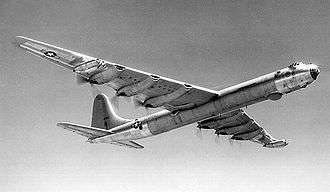 | |
| The B-36D used both piston and jet engines. | |
| Role | Strategic bomber |
| National origin | United States |
| Manufacturer | Convair |
| First flight | 8 August 1946 |
| Introduction | 1949 |
| Retired | 12 February 1959 |
| Primary user | United States Air Force |
| Produced | 1946–1954 |
| Number built | 384 |
| Unit cost |
US$4.1 million (B-36D) |
| Variants | Convair XC-99 Convair NB-36H Convair X-6 |
| Developed into | Convair YB-60 |
The Convair B-36 "Peacemaker"[N 1] was a strategic bomber built by Convair and operated solely by the United States Air Force (USAF) from 1949 to 1959. The B-36 was the largest mass-produced piston-engined aircraft ever built. It had the longest wingspan of any combat aircraft ever built, at 230 ft (70.1 m). The B-36 was the first bomber capable of delivering any of the nuclear weapons in the U.S. arsenal from inside its four bomb bays without aircraft modifications. With a range of 10,000 mi (16,000 km) and a maximum payload of 87,200 lb (39,600 kg), the B-36 was capable of intercontinental flight without refuelling.
Entering service in 1948, the B-36 was the primary nuclear weapons delivery vehicle of the Strategic Air Command (SAC) until it was replaced by the jet-powered Boeing B-52 Stratofortress from 1955. All but five examples were scrapped.
The B-36 set the standard for range and payload for subsequent U.S. intercontinental bombers.
Development
The genesis of the B-36 can be traced to early 1941, prior to the entry of the United States into World War II. At the time it appeared there was a very real chance that Britain might fall to the Nazi "Blitz", making a strategic bombing effort by the United States Army Air Corps (USAAC) against Germany impossible with the aircraft of the time.[2] The United States would need a new class of bomber which would reach Europe and return to bases in North America,[3] necessitating a combat range of at least 5,700 miles (9,200 km), the length of a Gander, Newfoundland–Berlin round trip. The USAAC therefore sought a bomber of truly intercontinental range,[4][5] similar to the German RLM's ultra-long-range Amerika Bomber program, which itself as a 33-page proposal was submitted to Reichsmarschall Hermann Goering on May 12, 1942 at the RLM.
The USAAC sent out the initial request on 11 April 1941, asking for a 450 mph (720 km/h) top speed, a 275 mph (443 km/h) cruising speed, a service ceiling of 45,000 ft (14,000 m), beyond the range of ground-based anti-aircraft fire, and a maximum range of 12,000 miles (19,000 km) at 25,000 ft (7,600 m).[6] These proved too demanding — far exceeding the technology of the day — for any short-term design,[4] so on 19 August 1941 they were reduced to a maximum range of 10,000 mi (16,000 km), an effective combat radius of 4,000 mi (6,400 km) with a 10,000 lb (4,500 kg) bombload, a cruising speed between 240 and 300 mph (390 and 480 km/h), and a service ceiling of 40,000 ft (12,000 m),[3] above the maximum effective altitude of all of Nazi Germany's anti-aircraft Flak guns, save for the rarely deployed 12.8 cm FlaK 40 heavy Flak cannon.
World War II and after
As the Pacific war progressed, the air force increasingly needed a bomber capable of reaching Japan from its bases in Hawaii, and the development of the B-36 resumed in earnest. Secretary of War Henry L. Stimson, in discussions with high-ranking officers of the USAAF, decided to waive normal army procurement procedures, and on 23 July 1943 — just over two months after the Germans' Amerika Bomber proposal's submission — the USAAF ordered 100 B-36s before the completion and testing of the two prototypes.[7] The first delivery was due in August 1945, and the last in October 1946, but Consolidated (by this time renamed Convair) delayed delivery. The aircraft was unveiled on 20 August 1945, and flew for the first time on 8 August 1946.[8]
After the establishment of an independent United States Air Force in 1947, the beginning in earnest of the Cold War with the 1948 Berlin Airlift, and the 1949 atmospheric test of the first Soviet atomic bomb, American military planners sought bombers capable of delivering the very large and heavy first-generation atomic bombs. The B-36 was the only American aircraft with the range and payload to carry such bombs from airfields on American soil to targets in the USSR. The modification to allow the use of larger atomic weapons on the B-36 was called the "Grand Slam Installation."[9]
The B-36 was arguably obsolete from the outset, being piston-powered, coupled with the widespread introduction of first generation jet fighters in potential enemy air forces.[2][10] But its jet rival, the Boeing B-47 Stratojet, which did not become fully operational until 1953, lacked the range to attack the Soviet homeland from North America without aerial refueling and could not carry the huge first-generation Mark 16 hydrogen bomb. The other American piston bombers of the day, the B-29 and B-50, were also too limited in range and nuclear arsenal.[11] Intercontinental ballistic missiles (ICBMs) did not become sufficiently reliable until the early 1960s. Until the Boeing B-52 Stratofortress became operational in 1955, the B-36, as the only truly intercontinental bomber, continued to be the primary nuclear weapons delivery vehicle of the Strategic Air Command (SAC).[2]
Convair touted the B-36 as the "aluminum overcast", a so-called "long rifle" giving SAC truly global reach.[2] While General Curtis LeMay headed SAC (1949–57), he turned the B-36 arm, through intense training and development, into an effective nuclear delivery force, forming the heart of the Strategic Air Command. Its maximum payload was more than four times that of the B-29, and exceeding that of the B-52. The B-36 was slow and could not refuel in midair, but could fly missions to targets 3,400 mi (5,500 km) away and stay aloft as long as 40 hours.[2] Moreover, the B-36 was believed to have "an ace up its sleeve": a phenomenal cruising altitude for a piston-driven aircraft, made possible by its huge wing area and six 28-cylinder engines, putting it out of range of most of the interceptors of the day, as well as ground-based anti aircraft guns.[2]
Experimentals and prototypes


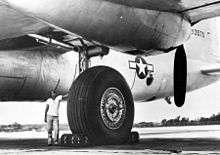
Consolidated Vultee Aircraft Corporation (later Convair) and Boeing Aircraft Company took part in the competition, with Consolidated winning a tender on 16 October 1941. Consolidated asked for a $15 million contract with $800,000 for research and development, mockup, and tooling. Two experimental bombers were proposed, the first to be delivered in 30 months, and the second within another six months. Originally designated Model B-35, the name was changed to B-36 to avoid confusion with the Northrop YB-35 piston-engined flying wing bomber,[4][12] against which the B-36 was meant to compete for a production contract.
Throughout its development, the B-36 would encounter delays. When the United States entered World War II, Consolidated was ordered to slow B-36 development and greatly increase Consolidated B-24 Liberator production. The first mockup was inspected on 20 July 1942, following six months of refinements. A month after the inspection, the project was moved from San Diego, California, to Fort Worth, Texas, which set back development several months. Consolidated changed the tail from a twin-tail to a single, thereby saving 3,850 pounds (1,750 kg), but this change delayed delivery by 120 days. The tricycle landing gear system's initial main gear design, with huge single wheels found to cause significant ground pressure problems, limited the B-36 to operating from just three air bases in the United States: Carswell Field (former Carswell AFB, now NAS JRB Fort Worth/Carswell Field), adjacent to the Consolidated factory in Fort Worth, Texas; Eglin Field (now Eglin AFB), Florida; and Fairfield-Suisun Field (now Travis AFB) in California[13]). As a result, the Air Force mandated that Consolidated design a four-wheeled bogie-type wheel system for each main gear unit instead, which distributed the pressure more evenly and reduced weight by 1,500 pounds (680 kg).[4][7][14] Changes in the United States Army Air Forces (USAAF) requirements would add back any weight saved in redesigns, and cost more time. A new antenna system needed to be designed to accommodate an ordered radio and radar system. The Pratt & Whitney engines were redesigned, adding another 1,000 pounds (450 kg).[15]
Design
The B-36 took shape as an aircraft of immense proportions. It was two-thirds longer than the previous "superbomber", the B-29. The wingspan and tail height of the B-36 exceeded those of the 1960s Soviet Union's Antonov An-22 Antheus military transport, the largest ever propeller-driven aircraft ever put into production.[2] Only with the advent of the Boeing 747 and the Lockheed C-5 Galaxy, both designed two decades later, did American aircraft capable of lifting a heavier payload become commonplace.
The wings of the B-36 were large even when compared with present-day aircraft, exceeding, for example, those of the C-5 Galaxy, and enabled the B-36 to carry enough fuel to fly the intended long missions without refueling. The maximum thickness of the wing, measured perpendicular to the chord, was 7.5 feet (2.3 m) thick, containing a crawlspace that allowed access to the engines.[16] The wing area permitted cruising altitudes well above the operating ceiling of any 1940s-era operational piston and jet-turbine fighters. Most versions of the B-36 could cruise at over 40,000 feet (12,000 m).[17] B-36 mission logs commonly recorded mock attacks against U.S. cities while flying at 49,000 feet (15,000 m). In 1954, the turrets and other nonessential equipment were removed (not entirely unlike the earlier Silverplate program for the atomic bomb-carrying "specialist" B-29s) that resulted in a "featherweight" configuration believed to have resulted in a top speed of 423 miles per hour (681 km/h),[18] and cruise at 50,000 feet (15,000 m) and dash at over 55,000 feet (17,000 m), perhaps even higher.[19]
The large wing area and the option of starting the four jet engines supplementing the piston engines in later versions gave the B-36 a wide margin between stall speed (VS) and maximum speed (Vmax) at these altitudes. This made the B-36 more maneuverable at high altitude than the USAF jet interceptors of the day, which either could not fly above 40,000 ft (12,000 m), or if they did, were likely to stall out when trying to maneuver or fire their guns.[20] However, the U.S. Navy argued that their McDonnell F2H Banshee fighter could intercept the B-36, thanks to its ability to operate at more than 50,000 feet (15,000 m).[21] The USAF declined the invitation from the U.S. Navy for a fly-off between the Banshee and the B-36. Later, the new Secretary of Defense, Louis A. Johnson, who considered the U.S. Navy and naval aviation essentially obsolete in favor of the U.S. Air Force and Strategic Air Command, forbade putting the navy's claim to the test.[22]
The propulsion system of the B-36 was unique, with six 28-cylinder Pratt & Whitney R-4360 'Wasp Major' radial engines mounted in an unusual pusher configuration, rather than the conventional four-engine, tractor propeller layout of other heavy bombers. The prototype R-4360s delivered a total of 18,000 hp (13,000 kW). While early B-36s required long takeoff runs, this situation was improved with later versions, delivering a significantly increased power output of 22,800 hp (17,000 kW) total.[23] Each engine drove a three-bladed propeller, 19 feet (5.8 m) in diameter, mounted in the pusher configuration, thought to be the second-largest diameter propeller design ever used to power a piston-engined aircraft. This unusual configuration prevented propeller turbulence from interfering with airflow over the wing, but could also lead to engine overheating due to insufficient airflow around the engines, resulting in inflight engine fires. See Operating and financial problems.
The large, slow-turning propellers interacted with the high pressure air flow behind the wings to produce an easily recognizable very low frequency pulse at ground level that betrayed approaching flights.
Addition of jet propulsion
Beginning with the B-36D, Convair added a pair of General Electric J47-19 jet engines suspended near the end of each wing; these were also retrofitted to all extant B-36Bs. Consequently, the B-36 was configured to have 10 engines, six radial propeller engines and four jet engines, leading to the B-36 slogan of "six turnin' and four burnin' ". The B-36 had more engines than any other mass-produced aircraft. The jet pods greatly improved takeoff performance and dash speed over the target. In normal cruising flight, the jet engines were shut down to conserve fuel. When the jet engines were shut down, louvers closed off the front of the pods to reduce drag and to prevent ingestion of sand and dirt. The jet-engine louvers were opened and closed by the flight crew in the cockpit, whether the B-36 was on the ground or in the air.[24] The two pods with four turbojets and the six piston engines combined gave the B-36 a total of 40,000 hp (30,000 kW) for short periods of time.[25]
Crew
The B-36 had a crew of 15. As in the B-29 and B-50, the pressurized flight deck and crew compartment were linked to the rear compartment by a pressurized tunnel through the bomb bay. In the B-36, movement through the tunnel was on a wheeled trolley, pulling on a rope. The rear compartment featured six bunks and a dining galley, and led to the tail turret.[26]
Landing gear
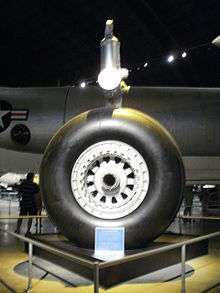
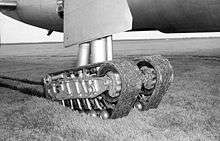
The XB-36 featured a single-wheel main landing gear whose tires were the largest ever manufactured up to that time, 9 feet 2 inches (2.79 m) tall, 3 feet (91 cm) wide, and weighing 1,320 pounds (600 kg), with enough rubber for 60 automobile tires.[2] These tires placed so much pressure on runways, the XB-36 was restricted to the Fort Worth airfield adjacent to the plant of manufacture, and to a mere two USAF bases beyond that. At the suggestion of General Henry H. Arnold, the single-wheel gear was soon replaced by a four-wheel bogie.[27] At one point, a tank-like tracked landing gear was also tried on the XB-36, but proved heavy and noisy and was quickly abandoned.
Weaponry
The four bomb bays could carry up to 86,000 pounds (39,000 kg) of bombs, more than 10 times the load carried by the World War II workhorse, the Boeing B-17 Flying Fortress, and substantially more than the entire B-17's gross weight.[28] The B-36 was not designed with nuclear weaponry in mind, because the mere existence of such weapons was top secret during the period when the B-36 was conceived and designed (1941–46). Nevertheless, the B-36 stepped into its nuclear delivery role immediately upon becoming operational. In all respects except speed, the B-36 could match what was arguably its approximate Soviet counterpart, the turboprop-powered Tu-95, which began production in January 1956 and was still in active service as of June 2016.[29] Until the B-52 became operational, the B-36 was the only means of delivering the first generation Mark-17 hydrogen bomb,[30] 25 ft (7.6 m) long, 5 ft (1.5 m) in diameter, and weighing 42,000 lb (19,000 kg), the heaviest and bulkiest American aerial nuclear bomb ever. Carrying this massive weapon required merging two adjacent bomb bays.
The defensive armament consisted of six remote-controlled retractable gun turrets, and fixed tail and nose turrets. Each turret was fitted with two 20 mm cannons, for a total of 16. Recoil vibration from gunnery practice often caused the aircraft's electrical wiring to jar loose or the vacuum tube electronics to malfunction, leading to failure of the aircraft controls and navigation equipment; this contributed to the crash of B-36B 44-92035 on 22 November 1950.[31]
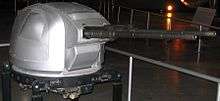
The Convair B-36 was the only aircraft designed to carry the T-12 Cloudmaker, a gravity bomb weighing 43,600 lb (19,800 kg) and designed to produce an earthquake bomb effect. Part of the testing process involved dropping two of the bombs on a single flight mission, one from 30,000 feet and the second from 40,000 feet, for a total bomb load of 87,200 pounds.
The first prototype XB-36 flew on 8 August 1946. The speed and range of the prototype failed to meet the standards set out by the Army Air Corps in 1941. This was expected, as the Pratt & Whitney R-4360 engines required were not yet available, and there was a lack of the qualified workers and materials needed to install them.[7][32]
A second aircraft, the YB-36, flew on 4 December 1947. It had a redesigned high-visibility, yet still "greenhouse-like" bubble canopy, heavily framed due to its substantial size, which was later adopted for production, and the engines used on the YB-36 were a good deal more powerful and more efficient. Altogether, the YB-36 was much closer to the production aircraft.

The first of 21 B-36As were delivered in 1948. They were interim airframes, intended for crew training and later conversion. No defensive armament was fitted, since none was ready. Once later models were available, all B-36As were converted to RB-36E reconnaissance models. The first B-36 variant meant for normal operation was the B-36B, delivered beginning in November 1948. This aircraft met all the 1941 requirements, but had serious problems with engine reliability and maintenance (changing the 336 spark plugs was a task dreaded by ground crews) and with the availability of armaments and spare parts. Later models featured more powerful variants of the R-4360 engine, improved radar, and redesigned crew compartments.
The four jet engines increased fuel consumption and reduced range. The advent of air-to-air missiles then rendered conventional gun turrets obsolete. In February 1954 the USAF awarded Convair a contract for a new "Featherweight" design program which significantly reduced weight and crew size. There were three configurations:
- Featherweight I removed defensive hardware, including the six gun turrets.
- Featherweight II removed the rear compartment crew comfort features, and all hardware accommodating the McDonnell XF-85 Goblin parasite fighter.
- Featherweight III incorporated both configurations I and II.
The six turrets eliminated by Featherweight I reduced the aircraft's crew from 15 to 9. Featherweight III had a longer range and an operating ceiling of at least 47,000 feet (14,000 m), especially valuable for reconnaissance missions. The B-36J-III configuration (the last 14 made) had a single radar-aimed tail turret, extra fuel tanks in the outer wings, and landing gear allowing the maximum gross weight to rise to 410,000 pounds (190,000 kg).
Production of the B-36 ceased in 1954.[33]
Operating and financial problems
Due to problems that occurred with the B-36 in its early stages of testing, development and later in service, some critics referred to the aircraft as a "billion-dollar blunder".[34] In particular, the United States Navy saw it as a costly bungle, diverting congressional funding and interest from naval aviation and aircraft carriers in general, and carrier–based nuclear bombers in particular. In 1947, the Navy attacked congressional funding for the B-36, alleging it failed to meet Pentagon requirements. The U.S. Navy held to the preeminence of the aircraft carrier in the Pacific during World War II, presuming carrier-based aircraft would be decisive in future wars. To this end, the Navy designed USS United States (CVA-58), a "supercarrier" capable of launching huge fleets of tactical aircraft or nuclear bombers. It then pushed to have funding transferred from the B-36 to the USS United States. The Air Force successfully defended the B-36 project, and the United States was officially cancelled by Secretary of Defense Louis A. Johnson in a cost-cutting move. Several high-level Navy officials questioned the government's decision, alleging a conflict of interest because Johnson had once served on Convair's board of directors. The uproar following the cancellation of United States in 1949 was nicknamed the "Revolt of the Admirals".[35]
The furor, as well as the significant use of aircraft carriers in the Korean War, resulted in the design and procurement of the subsequent Forrestal class of supercarriers, which were of comparable size to the United States, but with a design geared towards greater multirole use with composite air wings of fighter, attack, reconnaissance, electronic warfare, early warning and anti-submarine warfare aircraft. At the same time, heavy manned bombers for the Strategic Air Command were also deemed crucial to national defense and, as a result, the two systems were never again in competition for the same budgetary resources.[36][37]
Operational history
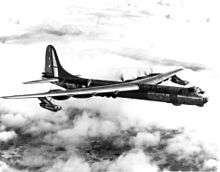
The B-36, including its GRB-36, RB-36, and XC-99 variants, was in USAF service as part of the Strategic Air Command from 1948 to 1959. The RB-36 variants of the B-36 were used for reconnaissance during the Cold War with the Soviet Union and the B-36 bomber variants conducted training and test operations and stood ground and airborne alert, but the latter variants were never used offensively as bombers against hostile forces; it never fired a shot in combat.
Maintenance
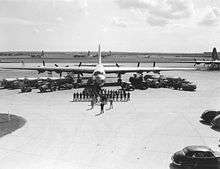
The Wasp Major engines had a prodigious appetite for lubricating oil: each engine required a dedicated 100 gal (380 l) tank. Normal maintenance consisted of tedious measures, like changing the 56 spark plugs on each of the six engines; the plugs were often fouled by the lead in the 145 octane anti-knock fuel required by the R-4360 engines. Thus, each service required changing 336 spark plugs. Another frequent maintenance job was replacing the dozens of bomb bay light bulbs, which routinely shattered during test firing of the ball turret guns.
The B-36 was too large to fit in most hangars. Since even an aircraft with the range of the B-36 needed to be stationed as close to enemy targets as possible, this meant the plane was largely based in the extreme weather locations of the northern continental United States, Alaska and the Arctic. Since the maintenance had to be performed outdoors, the crews were largely exposed to the elements, with temperatures of −60 °F (−51 °C) in winters and 100 °F (38 °C) in summers, depending on the airbase location. Special shelters were built so that the maintenance crews could be given a modicum of protection. Ground crews were at risk of slipping and falling from icy wings, or being blown off the wings by propeller wash running in reverse pitch. The wing roots were thick enough, at 7 ft (2.1 m), to enable a flight engineer to access the engines and landing gear during flight by crawling through the wings. This was possible only at altitudes not requiring pressurization.[38]
In 1950, Convair (then still Consolidated-Vultee) developed streamlined pods, looking like oversize drop tanks, that were mounted on each side of the B-36's fuselage to carry spare engines between bases. Each pod could airlift two engines. When the pods were empty, they were removed and carried in the bomb bays. There is no record of the special engine pods ever being used.[39]
Engine fires
As engine fires occurred with the B-36's radial engines, some crews humorously changed the aircraft's slogan from "six turning, four burning" into "two turning, two burning, two smoking, two choking, and two more unaccounted for."[40][N 2] This problem was exacerbated by the propellers' pusher configuration, which increased carburetor icing. The design of the R-4360 engine tacitly assumed that it would be mounted in the conventional tractor configuration—propeller/air intake/28 cylinders/carburetor—with air flowing in that order. In this configuration, the carburetor is bathed in warmed air flowing past the engine, and so is unlikely to ice up. However, the R-4360 engines in the B-36 were mounted backwards, in the pusher configuration—air intake/carburetor/28 cylinders/propeller. The carburetor was now in front of the engine and so could not benefit from engine heat, and also made more traditional short term carburetor heat systems unsuitable. Hence, when intake air was cold and humid, ice gradually obstructed the carburetor air intake, which in turn gradually increased the richness of the air/fuel mixture until the unburned fuel in the exhaust caught fire.[41] Three engine fires of this nature led to the first loss of an American nuclear weapon.
Crew experience
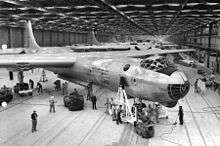
Training missions were typically in two parts; first, a 40-hour flight—followed by some time on the ground for refueling and maintenance—then a 24-hour second flight. With a sufficiently light load, the B-36 could fly at least 10,000 mi (16,000 km) nonstop, and the highest cruising speed of any version, the B-36J-III, was at 230 mph (380 km/h). Engaging the jet engines could raise the cruising speed to over 400 mph (650 km/h). Hence a 40-hour mission, with the jets used only for takeoff and climbing, flew about 9,200 mi (15,000 km).
Given the massive proportions of the plane, its overall performance was never considered sprightly or agile. For instance Lieutenant General James Edmundson likened it to "...sitting on your front porch and flying your house around."[42] Despite its immense exterior size, the pressurized crew compartments were relatively cramped, especially when occupied for 24 hours by a crew of 15 in full flight kit.
War missions would have been one-way, taking off from forward bases in Alaska or Greenland, overflying the USSR, with survivors landing in Europe, North Africa (Morocco), or the Middle East. Recollections of crew veterans reveal that, while crews were confident of their ability to complete a mission, they were less confident of surviving the weapon delivery itself.[43] Their concerns were about dropping extremely powerful bombs from a relatively slow-moving aircraft, leaving the aircraft within blast range. Their concerns were borne out during the 1954 Operation Castle tests. Here B-36s were flown at the combat distance from the detonations of bombs in the 15-megaton range. At distances believed typical of wartime delivery the aircraft suffered extensive flash and blast damage.[44]
Experiments
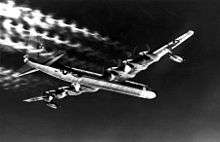
The B-36 was employed in a variety of aeronautical experiments throughout its service life. Its immense size, range and payload capacity lent itself to use in research and development programs. These included nuclear propulsion studies, and "parasite" programs in which the B-36 carried smaller interceptors or reconnaissance aircraft.[45]
In May 1946, the Air Force began the Nuclear Energy for the Propulsion of Aircraft (NEPA) project, which was followed in May 1951 by the Aircraft Nuclear Propulsion (ANP) program. The ANP program used modified B-36s to study shielding requirements for an airborne reactor to determine whether a nuclear powered aircraft was feasible. Convair modified two B-36s under the MX-1589 project. The Nuclear Test Aircraft (NTA) was a B-36H-20-CF (serial number 51-5712) that had been damaged in a tornado at Carswell AFB on 1 September 1952. This aircraft, designated the XB-36H (and later NB-36H), was modified to carry a 1 MW, air-cooled nuclear reactor in the aft bomb bay, with a four-ton lead disc shield installed in the middle of the aircraft between the reactor and the cockpit. A number of large air intake and exhaust holes were installed in the sides and bottom of the aircraft's rear fuselage to cool the reactor in flight.[46] On the ground, a crane would be utilized to remove the 35,000 pounds (16,000 kg) reactor from the aircraft. To protect the crew, the highly modified cockpit was encased in lead and rubber, with a 1-foot-thick (30 cm) leaded glass windshield.[46] The reactor was operational, but did not power the aircraft; its sole purpose was to investigate the effect of radiation on aircraft systems. Between 1955 and 1957, the NB-36H completed 47 test flights and 215 hours of flight time, during 89 of which the reactor was critical.
Other experiments involved providing the B-36 with its own fighter defense in the form of parasite aircraft carried partially or wholly in a bomb bay. One parasite aircraft was the diminutive McDonnell XF-85 Goblin, which docked using a trapeze system. The concept was tested successfully using a B-29 carrier, but docking proved difficult even for experienced test pilots. Moreover, the XF-85 was seen as no match for contemporary foreign powers' newly developed interceptor aircraft in development and in service; consequently, the project was cancelled.[47]
More successful was the FICON project, involving a modified B-36 (called a GRB-36D "mothership") and the RF-84K, a fighter modified for reconnaissance, in a bomb bay. The GRB-36D would ferry the RF-84K to the vicinity of the objective, whereupon the RF-84K would disconnect and begin its mission. Ten GRB-36Ds and 25 RF-84Ks were built and saw limited service in 1955–1956.
Projects TIP TOW and Tom-Tom involved docking F-84s to the wingtips of B-29s and B-36s. The hope was that the increased aspect ratio of the combined aircraft would result in a greater range. Project TIP TOW was canceled when an EF-84D and a specially modified test EB-29A crashed, killing everyone on both aircraft. This accident was attributed to the EF-84D flipping over onto the wing of the EB-29A. Project Tom-Tom, involving RF-84Fs and a GRB-36D from the FICON project (redesignated JRB-36F), continued for a few months after this crash, but was also canceled due to the violent turbulence induced by the wingtip vortices of the B-36.[48]
Strategic reconnaissance

One of the SAC's initial missions was to plan strategic aerial reconnaissance on a global scale. The first efforts were in photo-reconnaissance and mapping. Along with the photo-reconnaissance mission, a small electronic intelligence (ELINT) cadre was operating. Weather reconnaissance was part of the effort, as was Long Range Detection, the search for Soviet atomic explosions. In the late 1940s, strategic intelligence on Soviet capabilities and intentions was scarce. Before the development of the Lockheed U-2 high altitude spy plane and orbital reconnaissance satellites Corona, technology and politics limited American reconnaissance efforts to the borders, and not the heartland, of the Soviet Union.[50]
One of the essential criteria of the early postwar reconnaissance aircraft was the ability to cruise above 40,000 feet (12,000 m), a level determined by knowledge of the capability of Russian air defense radar. The main Russian air defense radar in the 1950s was the American supplied SCR-270, or locally made copies, which were only effective up to 40,000 feet (12,000 m) – in theory, an aircraft cruising above this level would remain undetected.[51]
The first aircraft to put this theory to the test was the RB-36D specialized photographic-reconnaissance version of the B-36D. It was outwardly identical to the standard B-36D, but carried a crew of 22 rather than 15, the additional crew members being needed to operate and maintain the photographic reconnaissance equipment that was carried. The forward bomb bay in the bomber was replaced by a pressurized manned compartment that was filled with fourteen cameras. This compartment included a small darkroom where a photo technician could develop the film. The second bomb bay contained up to 80 T-86 photoflash bombs, while the third bay could carry an extra 11,000 litres (3,000 US gal) droppable fuel tank. The fourth bomb bay carried ECM equipment. The defensive armament of 16 M-24A-1 20 mm cannons was retained. The extra fuel tanks increased the flight endurance to up to 50 hours. It had an operational ceiling of 50,000 feet (15,000 m). Later, a lightweight version of this aircraft, the RB-36-III, could even reach 58,000 ft (18,000 m). RB-36s were distinguished by the bright aluminium finish of the camera compartment (contrasting with the dull magnesium of the rest of the fuselage) and by a series of radar domes under the aft fuselage, varying in number and placement. When developed, it was the only American aircraft having enough range to fly over the Eurasian land mass from bases in the United States, and size enough to carry the bulky high resolution cameras of the day.[52]
The standard RB-36D carried up to 23 cameras, primarily K-17C, K-22A, K-38, and K-40 cameras. A special 240-inch focal length camera (known as the Boston Camera after the university where it was designed) was tested on 44-92088, the aircraft being redesignated ERB-36D. The long focal length was achieved by using a two-mirror reflection system. The camera was capable of resolving a golf ball at an altitude and side range of 45,000 feet (14,000 m). That is a slant range of over 63,600 feet (19,400 m). See the contact print of this test at the National Museum of the United States Air Force at Wright Patterson AFB. This camera is now with the National Museum of the United States Air Force at Wright Patterson AFB.[52]
The first RB-36D (44-92088) made its initial flight on 18 December 1949, only six months after the first B-36D had flown. It initially flew without the turbojets. The 28th Strategic Reconnaissance Wing based at Rapid City AFB (later renamed Ellsworth AFB), South Dakota received its first RB-36D on 3 June 1950. Due to severe materiel shortages, the new RB-36Ds did not become operationally ready until June 1951. The 24th and last RB-36D was delivered in May 1951. A total of 24 RB-36Ds were built. Some RB-36Ds were later modified to the featherweight configuration, in which all but the tail guns were removed. The crew was reduced from 22 to 19. These aircraft were redesignated as RB-36D-III. Modifications were carried out by Convair from February 1954 to November 1954.[52]
With a range of 9,300 miles (15,000 km), RB-36Ds began probing the boundaries of the Soviet Arctic in 1951. Although on-board equipment indicated detection by Soviet radar, interceptions at the B-36's service ceiling would have remained difficult. RB-36 aircraft operating from RAF Sculthorpe in England made a number of overflights of Soviet Arctic bases, particularly the new nuclear weapons test complex at Novaya Zemlya. RB-36s performed a number of rarely acknowledged reconnaissance missions and are believed to have frequently penetrated Chinese (and Soviet) airspace under the direction of General Curtis LeMay.[51]
In early 1950, Convair began converting B-36As to a reconnaissance configuration; included in the conversions was the sole YB-36 (42-13571). These converted examples were all redesignated RB-36E. The six R-4360-25 engines were replaced by six R-4360-41s. They were also equipped with the four J-47 jet engines that were fitted to the RB-36D. Its normal crew was 22, which included five gunners to man the 16 M-24A-1 20 mm cannon. The last conversion was completed in July 1951. Later, the USAF also bought 73 long-range reconnaissance versions of the B-36H under the designation RB-36H. 23 were accepted during the first six months of 1952, the last were delivered by September 1953. More than a third of all B-36 models were reconnaissance models.[52]
Advances in Soviet air defense systems meant that the RB-36 became limited to flying outside the borders of the Soviet Union, as well as Eastern Europe. By the mid-1950s, the jet-powered Boeing RB-47E was able to pierce Soviet airspace and conduct a variety of spectacular overflights of the Soviet Union. Some of these flights probed deep into the heart of the Soviet Union, taking a photographic and radar recording of the route attacking SAC bombers would follow to reach their targets. The risks involved in mounting these dangerous sorties over some of the most inhospitable terrain on earth speaks volumes for the courage and skill of the crews involved. Flights which involved penetrating mainland Russia were termed SENSINT (Sensitive Intelligence) missions. One RB-47 even managed to fly 450 miles (720 km) inland and photograph the city of Igarka in Siberia.[51]
As with the strategic bombardment versions of the B-36, the RB-36s were phased out of the SAC inventory beginning in 1956, the last being sent to Davis–Monthan Air Force Base in January 1959.
Obsolescence
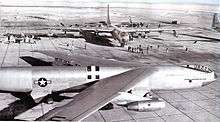

With the appearance of the excellent Soviet Mikoyan-Gurevich MiG-15 in combat over North Korea in 1950, USAF propeller-driven bombers were rendered obsolete as strategic offensive weapons. During daylight, the MiG-15 could, and did, attack the propeller-driven B-29s, forcing the U.S. to switch the B-29 to night raids.
The B-36, along with the B-29/B-50 Superfortresses in the USAF inventory in the early 1950s, were all designed during World War II prior to the jet age. It would take a new generation of swept-wing jet bombers, able to fly higher and faster, to effectively overcome defense by MiG-15 or subsequent Soviet-designed interceptors if the Cold War escalated into an armed conflict between the United States and Soviet Union.
With the end of fighting in Korea, President Eisenhower, who had taken office in January 1953, called for a "new look" at national defense. His administration chose to invest in the Air Force, especially Strategic Air Command. The Air Force retired nearly all of its B-29/B-50s to be replaced by the new Boeing B-47 Stratojet. By 1955, the swept wing Boeing B-52 Stratofortress was entering the inventory in substantial numbers, replacing B-36s.
The two main factors contributing to the obsolescence of the B-36 and leading to its phaseout were:
- The Peacemaker was not designed for aerial refueling, and required intermediate refueling bases to reach its planned targets deep in the Soviet Union.
- Its slow speed made it vulnerable to Soviet jet interceptor aircraft, making long-range bombardment flights over Soviet territory extremely hazardous, seriously compromising its ability to reach its planned target and return.
The scrapping of B-36s began in February 1956. Once replaced by B-52s, they were flown directly from operational squadrons to Davis-Monthan AFB, Arizona, where the Mar-Pak Corporation handled their reclamation and destruction. Defense cutbacks in FY 1958 compelled the B-52 procurement process to be stretched out and the B-36 service life to be extended. The B-36s remaining in service were supported with components scavenged from aircraft sent to Davis-Monthan. Further update work was undertaken by Convair at San Diego (Specialized Aircraft Maintenance, SAM-SAC) until 1957 to extend the life and capabilities of the B-36s. By December 1958 only 22 B-36Js were still operational.[52]
On 12 February 1959, the last B-36J built, AF Ser. No. 52-2827, left Biggs AFB, Texas, where it had been on duty with the 95th Heavy Bombardment Wing, and was flown to Amon Carter Field in Fort Worth, where it was put on display. Within two years, all B-36s, except five used for museum display, had been scrapped at Davis-Monthan AFB.[52]
Variants
| Variant | Built |
|---|---|
| XB-36 | 1 |
| YB-36 | 1 |
| B-36A | 22 |
| XC-99 | 1 |
| B-36B | 62 |
| B-36D | 26 |
| RB-36D | 24 |
| B-36F | 34 |
| RB-36F | 24 |
| B-36H | 83 |
| RB-36H | 73 |
| B-36J | 33 |
| YB-60 | 2 |
| Total | 385[53] |
- XB-36
- Prototype powered by six 3,000 hp (2,200 kW) R-4360-25 engines and unarmed, one built.
- YB-36
- Prototype, s/n 42-13571,[54] with modified nose and raised cockpit roof, one built later converted to YB-36A.
- YB-36A
- Former YB-36 with modified four-wheel landing gear, later modified as a RB-36E.
- B-36A
- Production variant, unarmed, used for training, 22 built, all but one converted to RB-36E.
- XC-99
- A cargo/transport version of the B-36. One built.
- B-36B
- Armed production variant with six 3,500 hp (2,600 kW) R-4360-41 engines, 73 built, later conversions to RB-36D and B-36D.
- RB-36B
- Designation for 39 B-36Bs temporarily fitted with a camera installation.
- YB-36C
- Projected variant of the B-36B with six 4,300 hp (3,200 kW) R-4360-51 engines driving tractor propellers, not built.
- B-36C
- Production version of the YB-36, completed as B-36Bs.
- B-36D
- Same as B-36B, but fitted with four J47-GE-19 engines, two each in two underwing pods, 22 built and 64 conversions from B-36B.
- RB-36D
- Strategic reconnaissance variant with two bomb bays fitted with camera installation, 17 built and seven conversions from B-36B.
- GRB-36D
- Same as RB-36D, but modified to carry a GRF-84F Thunderstreak on a ventral trapeze as part of the FICON program, 10 modified.
- RB-36E
- The YB-36A and 21 B-36As converted to RB-36D standards.
- B-36F
- Same as B-36D, but fitted with six 3,800 hp (2,800 kW) R-4360-53 engines and four J47-GE-19 engines, 34 built.
- RB-36F
- Strategic reconnaissance variant of the B-36F with additional fuel capacity, 24 built.
- YB-36G
- See YB-60.
- B-36H
- Same as B-36F with improved cockpit and equipment changes, 83 built.
- NB-36H
- One B-36H fitted with a nuclear reactor installation for trials, had a revised cockpit and raised nose. This was intended to evolve into the Convair X-6.
- RB-36H
- Strategic reconnaissance variant of the B-36H, 73 built.
- B-36J
- High altitude variant with strengthened landing gear, increased fuel capacity, armament reduced to tail guns only and reduced crew, 33 built.
- YB-60
- Originally designated the YB-36G, s/n 49-2676 and 49-2684.[55] Project for a jet-powered swept wing variant. Due to the differences from a standard B-36 its designation was changed to YB-60.
Related models


In 1951, the USAF asked Convair to build a prototype of an all-jet variant of the B-36. Convair complied by replacing the wings on a B-36F with swept wings, from which were suspended eight Pratt & Whitney XJ57-P-3 jet engines. The result was the B-36G, later renamed the Convair YB-60. The YB-60 was deemed inferior to Boeing's YB-52, and the project was terminated.[56] Just as the C-97 was the transport variant of the B-50, the B-36 was the basis for the Convair XC-99, a double-decked military cargo plane that was the largest piston engined, land-based aircraft ever built, and the longest practical aircraft (185 ft/56 m) of its era. The sole example built was extensively employed for nearly 10 years, especially for cross-country cargo flights during the Korean War. In 2005, this XC-99 was dismantled in anticipation of its being moved from the former Kelly Air Force Base, now the Kelly Field Annex of Lackland AFB in San Antonio, Texas, where it had been retired since 1957. The XC-99 was subsequently relocated to the National Museum of the United States Air Force at Wright-Patterson Air Force Base near Dayton, Ohio for restoration, with C-5 Galaxy transports carrying pieces of the XC-99 to Wright-Patterson as space and schedule permitted.[57]
A commercial airliner derived from the XC-99, the Convair Model 37, never left the drawing board. It would have been the first "jumbo" airliner.[2]
Operators
United States Air Force – Strategic Air Command[58]
2d Air Force
- 72d Strategic Reconnaissance Wing – Ramey AFB, Puerto Rico (October 1952 - January 1959)
- 60th and 301st Strategic Reconnaissance Squadrons, Tail Code: Square F
- 6th Bombardment Wing – Walker AFB, New Mexico (August 1952 – August 1957)
- 24th, 39th and 40th Bombardment Squadrons, Tail Code: Triangle R
- 7th Bombardment Wing – Carswell AFB, Texas (June 1948 – May 1958)
- 9th, 436th and 492d Bombardment Squadrons, Tail Code: Triangle J
- 11th Bombardment Wing – Carswell AFB, Texas (December 1948 – December 1957)
- 26th, 42d and 98th Bombardment Squadrons, Tail Code: Triangle U
- 28th Strategic Reconnaissance Wing – Ellsworth AFB, South Dakota (May 1949 - April 1950)
- 77th, 717th and 718th Strategic Reconnaissance Squadrons, Tail Code: Circle X
- 42d Bombardment Wing, Loring AFB, Maine (April 1953 – September 1956)
- 69th, 70th and 75th Bombardment Squadrons
- 92d Bombardment Wing – Fairchild AFB, Washington (July 1951 – March 1956)
- 325th, 326th and 327th Bombardment Squadrons, Tail Code: Circle W
- 95th Bombardment Wing – Biggs AFB, Texas (August 1953 – February 1959)
- 334th, 335th and 336th Bombardment Squadrons
- 5th Strategic Reconnaissance Wing – Fairfield-Suison AFB (later Travis AFB), California (January 1951 – September 1958)
- 5th, 31st and 72d Strategic Reconnaissance Squadrons, Tail Code: Circle X
- 9th Strategic Reconnaissance Wing – Fairfield-Suison AFB, California (May 1949 – April 1950)
- 1st Bombardment Squadron
- 99th Strategic Reconnaissance Wing – Fairchild AFB, Washington (August 1951 – September 1956)
- 346th, 347th and 348th Strategic Reconnaissance Squadrons, Tail Code: Circle I
Note: SAC eliminated tail codes in 1953.
Aircraft on display
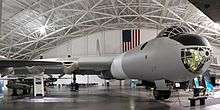


Only four complete (and one stored) B-36 type aircraft survive today, from the 384 produced.[59]
- YB-36/RB-36E
- AF Ser. No. 42-13571 – in the private collection of the late Walter Soplata in Newbury, Ohio.[60] This was the first prototype to be converted to the bubble canopy used on production B-36s. It was on display in the 1950s and 1960s at the former site of the Air Force Museum, now the National Museum of the United States Air Force, at Wright-Patterson Air Force Base near Dayton, Ohio. When the museum's current location at Wright-Patterson was being developed in the late 1950s, the cost of moving the bomber was more than simply flying a different B-36 to the new location and the aircraft was slated to be scrapped. It was cut up at the old museum site by August 1972. Instead of being completely disposed of, Soplata bought it and transported the pieces by truck to his farm, where it sits today. The bomb bay currently contains a complete P-47N still packed in its original shipping crate.[61]
- RB-36H
- AF Ser. No. 51-13730 – Castle Air Museum at the former Castle Air Force Base in Atwater, California. Previously displayed at Chanute Air Force Base in Rantoul, Illinois from 1957 to 1991.[62]
- B-36J
- AF Ser. No. 52-2217 – Strategic Air Command & Aerospace Museum, formerly located at Offutt Air Force Base, and now off-base near Ashland, Nebraska.[63]
- AF Ser. No. 52-2220 – National Museum of the United States Air Force (NMUSAF), formerly The U.S. Air Force Museum, at Wright-Patterson Air Force Base near Dayton, Ohio. Its flight to the museum from Davis-Monthan Air Force Base in Arizona on 30 April 1959 was the last flight of a B-36. This B-36J replaced the former Air Force Museum's original YB-36, AF Serial Number 42-13571 (see above). This was also the first aircraft to be placed in the Museum's new display hangar, and was not moved again until relocated to the Museum's latest addition in 2003. It is displayed alongside the only surviving example of the massive 9 ft (2.7 m) lower main gear strut, single wheel and tire that was used on the original XB-36.[64]
- AF Ser. No. 52-2827 – Pima Air & Space Museum, adjacent to Davis-Monthan Air Force Base in Tucson, Arizona. This aircraft was the final B-36 built, named "The City of Fort Worth", and loaned to the city of Fort Worth, Texas on 12 February 1959. It sat on the field at the Greater Southwest International Airport until that airfield was closed and the property was redeveloped as a business park adjacent to Dallas-Fort Worth International Airport. Some attempts were made to begin restoration at that location through the early 1970s. It then moved to the short-lived Southwest Aero Museum, which was located between the former Carswell Air Force Base (now Naval Air Station Joint Reserve Base Fort Worth) and the former General Dynamics (now Lockheed Martin) assembly plant, where it was originally built; some restoration took place while at the plant. As Lockheed Martin had no place to display the finished aircraft, and local community efforts in Fort Worth to build a facility to house and maintain the massive aircraft fell short, the NMUSAF retook possession of the aircraft and it was transported to Tucson, Arizona for loan to the Pima Air & Space Museum. It was fully restored and reassembled at that museum, just south of Davis-Monthan AFB, Arizona, and is displayed at that location.[65]
Notable incidents and accidents
Though the B-36 had a solid overall safety record, well above averages for the class and time, a total of 10 B-36s were involved in accidents between 1949 and 1954 (three B-36Bs, three B-36Ds, and four B-36Hs).[66] A total of 32 B-36s were written off in accidents between 1949 and 1957 of 385 built.[67] When a crash occurred, the magnesium-rich airframe burned easily.[68]
On Labor Day, Monday, 1 September 1952, a tornado hit Carswell Air Force Base, Fort Worth, Texas damaging aircraft of the 7th and 11th Bomber Wings' complement of B-36s. Some two thirds of the USAF's entire B-36 fleet were affected, as well as six aircraft being built at that point at Convair's Fort Worth plant. The base was shut down and operations transferred to Meacham Field. Joint repairs by Convair and the USAF got 10 of the 61 B-36s up and running within two weeks and repaired the other 51 aircraft within five weeks. 18 of 19 heavily damaged aircraft (and the six damaged and unfinished aircraft at Convair) were repaired by May 1953. The 19th (#2051) had to be scrapped, and was used as a nuclear testing site ground target. One heavily damaged aircraft (#5712) was written off and rebuilt as the NB-36H Nuclear Reactor Testbed aircraft.[69]
On March 18, 1953, RB-36H-25, 51-13721, got off course in bad weather and crashed near Burgoynes Cove, Newfoundland, Canada. Brigadier General Richard Ellsworth was among the 23 airmen killed in the crash.
B-36s were involved in two "Broken Arrow" incidents. On 13 February 1950, B-36 serial number 44-92075, crashed in an unpopulated region of British Columbia, resulting in the first loss of an American atom bomb. The bomb's plutonium core was dummy lead, but it did have TNT, and it detonated over the ocean before the crew bailed out.[70] Locating the crash site took some effort.[71] On 4 November 2016, however, it was reported that an object similar to the bomb had been located by a diver near the archipelago of Haida Gwaii, 80 km (50 mi) off the coast of British Columbia; the Royal Canadian Navy said vessels would be deployed to investigate the object.[72] After investigation, the Royal Canadian Navy determined that it was not the lost bomb.[73] Later in 1954, the airframe, stripped of sensitive material, was substantially destroyed in situ by a U.S. military recovery team.
On 22 May 1957, a B-36 accidentally dropped a Mark 17 nuclear bomb on a deserted area while landing at Kirtland Air Force Base in Albuquerque, New Mexico. Only the conventional trigger detonated, the bomb being unarmed. These incidents were classified for decades. See list of military nuclear accidents.[66][74]
Specifications (B-36J-III)
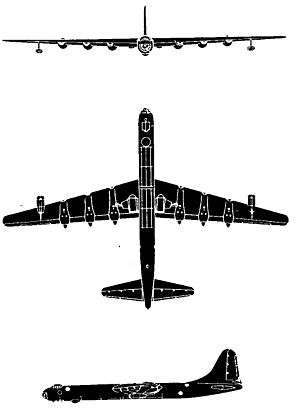
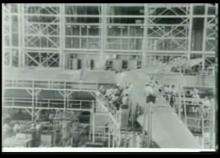
Data from National Museum of the U.S. Air Force[75]
General characteristics
- Crew: 13
- Length: 162 ft 1 in (49.42 m)
- Wingspan: 230 ft 0 in (70.12 m)
- Height: 46 ft 9 in (14.25 m)
- Wing area: 4,772 ft²[76] (443.5 m²)
- Airfoil: NACA 63(420)-422 root, NACA 63(420)-517 tip
- Empty weight: 166,165 lb (75,530 kg)
- Loaded weight: 262,500 lb[76] (119,318 kg) (combat weight)
- Max. takeoff weight: 410,000 lb (186,000 kg)
- Powerplant:
- 4 × General Electric J47 turbojets, 5,200 lbf (23.2 kN) each
- 6 × Pratt & Whitney R-4360-53 "Wasp Major" radials, 3,800 hp (2,835 kW) each
Performance
- Maximum speed: 435 mph (363 knots, 672 km/h)
- Cruise speed: 230 mph (200 knots, 370 km/h)
- Combat radius: 3,985 mi (3,465 nmi,[76] 6,415 km)
- Ferry range: 10,000 mi (8,700 nmi, 16,000 km)
- Service ceiling: 43,600 ft (13,300 m)
- Rate of climb: 1,995 ft/min (10.1m/s)
Armament
- Guns: 1 remotely operated tail turret with 2× 20 mm (0.787 in) M24A1 autocannons[76]
- Bombs: 86,000 lb (39,000 kg) with weight restrictions, 72,000 lb (32,700 kg) normal[76]
Notable appearances in media
In 1949, the B-36 was featured in the documentary film, Target: Peace, which was centered around the operations of the 7th Bombardment Wing at Carswell AFB. Other scenes included B-36 production at the Fort Worth plant.
In 1955, the film Strategic Air Command was released, starring James Stewart and June Allyson with Stewart playing a baseball star and his subsequent service in Strategic Air Command. The flying sequences (and sounds) of the B-36 dominate the film. This film remains as the only full-length film featuring this aircraft.[77] The B-36 also appeared in the 1957 Howard Hughes film Jet Pilot, which starred John Wayne and Janet Leigh.[78]
The documentary Lost Nuke (2004) chronicles a 2003 Canadian expedition that set out to solve the mystery of the world's first lost nuclear weapon. The team traveled to the remote mountain British Columbia crash site of 44-92075.[79]
Lore

Throughout its time in service, the B-36 was the subject of USAF lore, some apocryphal, some containing a grain of truth.
"If all engines function normally at full power during the pre-takeoff warm-up, the lead flight engineer will sometimes say to the Aircraft Commander (AC), 'six turning and four burning.'" Erratic reliability led to the wisecrack, 'two turning, two burning, two joking (sic), and two smoking, with two engines not accounted for.'"— Michael Daciek quoting Capt. Banda[40]
See also
- B-36 Peacemaker Museum
- Convair B-36 variants
- Lycoming R-7755
- Revolt of the Admirals
- "Victory Bomber"
- Kégresse track
- Related development
- Aircraft of comparable role, configuration and era
- Related lists
References
Notes
- ↑ Convair proposed the name "Peacemaker" in a submission to a contest to name the bomber. Although the name "Peacemaker" was not officially adopted, it was commonly used and sources often state or imply the name is "official".[1]
- ↑ Quote attributed to Captain Banda when he was escorting Air Cadet Michael R. Daciek, later Lieutenant Colonel Daciek, on an inside tour of the XC-99 in 1953.
Citations
- ↑ "Peacemaker Name Certificate." Archived 26 April 2007 at the Wayback Machine. 7th Bomb Wing B-36 Association. Retrieved: 28 August 2010.
- 1 2 3 4 5 6 7 8 9 "Convair XB-36 Factsheet." Archived 10 March 2007 at the Wayback Machine. National Museum of the United States Air Force. Retrieved: 15 May 2010.
- 1 2 Taylor 1969, p. 465.
- 1 2 3 4 Johnson 1978, p. 1.
- ↑ Jacobsen and Wagner 1980, p. 4.
- ↑ Winchester 2006, p. 49.
- 1 2 3 "Weapons of Mass Destruction (WMD): B-36 Peacemaker." globalsecurity.org. Retrieved: 5 September 2009.
- ↑ "Video: Biggest Bomber, 1946/08/15." Universal Newsreel, 1946. Retrieved: 20 February 2012.
- ↑ "B-36 Peacemaker." globalsecurity.org. Retrieved: 17 January 2012.
- ↑ Wagner 1968, p. 142.
- ↑ Yenne 2004, pp. 124–126.
- ↑ Leach 2008, pp. 26–28.
- ↑ Jenkins 2002, pp. 14–15.
- ↑ Leach 2008, p. 29.
- ↑ Leach 2008, p. 30.
- ↑ Griswold, Wesley P. "Remember the B-36." Popular Science, September 1961. Retrieved: 15 May 2010.
- ↑ "Archived copy". Archived from the original on 8 November 2014. Retrieved 12 November 2014.
- ↑ Jacobsen 1974, p. 54.
- ↑ Yenne 2004, pp. 136–137.
- ↑ Jacobson and Meyer, The Big Stick.
- ↑ AU/ACSC/166/1998-04 "Standard Aircraft Characteristics: F2H-2 Banshee." Archived 6 December 2006 at the Wayback Machine. history.naval.mil. Retrieved: 28 August 2010.
- ↑ "The Revolt of the Admirals." Air Command and Staff College Air University. Retrieved: 15 May 2010.
- ↑ Yenne 2004, pp. 137–138.
- ↑ "Doors Shield Jets From Blowing Dirt" Popular Mechanics, October 1950, p. 117.
- ↑ "B-36 Adds Four Jet Engines." Popular Mechanics, July 1949, p. 124.
- ↑ Shiel 1996, p. 7.
- ↑ Puryear 1981, p. 26.
- ↑ "History: Boeing B-17." Archived 7 January 2007 at the Wayback Machine. boeing.com. Retrieved: 15 May 2010.
- ↑ "Russia sparks Cold War scramble." BBC News, 9 August 2007. Retrieved: 30 April 2010.
- ↑ "Mark 17." globalsecurity.org. Retrieved: 15 May 2010.
- ↑ Lockett, Brian. "Summary of Air Force accident report." Goleta Air and Space Museum, air-and-space.com. Retrieved: 15 May 2010.
- ↑ Leach 2008, p. 32.
- ↑ "The Last B-36 and the people who saved it from destruction." Archived 14 October 2007 at the Wayback Machine. cowtown.net, 1 October 2006. Retrieved: 21 September 2007.
- ↑ Wolk 2003, p. 163.
- ↑ Barlow 1994, p. 42.
- ↑
- McFarland, Keith (1980). "The 1949 Revolt of the Admirals" (PDF). Parameters: Journal of the US Army War College Quarterly Vol. XI, No. 2. pp. 53–63. Retrieved 28 April 2014.
- ↑ Barlow, Jeffrey G. Revolt of the Admirals: The Fight for Naval Aviation, 1945–1950. Washington, D.C.: Naval Historical Center, 1994. ISBN 0-16-042094-6.
- ↑ Morris, Ted. "Flying the Aluminum and Magnesium Overcast." zianet.com, 2000. Retrieved: 15 May 2010.
- ↑ "Bomber Carries Spare Engines." Popular Mechanics, September 1950, p. 146,
- 1 2 Daciek, Michael R. "Speaking at random about flying and writing: B-36 Peacemaker/Ten Engine Bomber." YourHub.com, 13 December 2006. Retrieved: 6 April 2009.
- ↑ Ricketts, Bruce. "Broken Arrow, A lost nuclear weapon in Canada: Interview with B-36B 44-92075 Co-pilot 1st Lt R.P. Whitfield." mysteriesofcanada.com, 1998. Retrieved: 24 September 2007.
- ↑ "Lt. General James Edmundson on: Flying B-36 and B-47 planes." American Experience, PBS, January 1999. Retrieved: 15 May 2010.
- ↑ "B-36 Era and Cold War Aviation Forum." delphiforums.com. Retrieved: 15 May 2010.
- ↑ "Operation Castle: Report of Commander, Task Group 7.1, p. 24 (extract version)." Archived 27 February 2008 at the Wayback Machine. worf.eh.doe.gov, 1 February 1980. Retrieved: 23 September 2007.
- ↑ Miller and Cripliver 1978, pp. 366, 369.
- 1 2 Baugher, Joe. "Convair NB-36H." USAF Bombers: Convair B-36 Peacemaker: joebaugher.com, 19 September 2000. Retrieved: 14 May 2010. Quote: "
- ↑ Baugher, Joe. "McDonnell XP-85/XF-85 Goblin." USAF Fighters: McDonnell XP-85/XF-85 Goblin, www.joebaugher.com, 23 October 1999. Retrieved: 14 May 2010.
- ↑ Lockett, Brian. "Parasite Fighter Programs: Project Tom-Tom." Goleta Air and Space Museum, air-and-space.com. Retrieved: 15 May 2010.
- ↑ Hall, R. Cargill. "The Truth About Overflights: Military Reconnaissance Missions over Russia Before the U-2." Quarterly Journal of Military History, Spring 1997.
- ↑ Wack, Fred J. The Secret Explorers: Saga of the 46th/72nd Reconnaissance Squadrons. Self-published, 1990.
- 1 2 3 Jacobsen 1997
- 1 2 3 4 5 6 Baugher, Joe. "Convair B-36 Peacemaker." USAF Bombers via joebaugher.com, 19 September 2000. Retrieved: 14 June 2010.
- ↑ Knaack 1988, p. 53.
- ↑ "Convair YB-36 'Peacemaker'." AeroWeb. Retrieved: 15 May 2010.
- ↑ "Convair YB-36G (YB-60) 'Peacemaker'." AeroWeb. Retrieved: 15 May 2010.
- ↑ "YB-60 Factsheet." Archived 15 November 2007 at the Wayback Machine. National Museum of the United States Air Force. Retrieved: 15 May 2010.
- ↑ Hill, 1st Lt Bruce R. Jr. "XC-99 begins piece-by-piece trip to Air Force Museum." Archived 3 November 2007 at the Wayback Machine. 433rd Airlift Wing Public Affairs, 22 April 2004.
- ↑ "B-36 Deployment." strategic-air-command.com. Retrieved: 14 June 2010.
- ↑ Yenne 2004, p. 149.
- ↑ Soplata, Wally. "Aircraft Collector Remembered for Heroic Quest to Save Historic Aircraft." Archived 16 December 2011 at the Wayback Machine. eaa.org, 9 December 2010. Retrieved: 31 December 2011.
- ↑ "B-36 Peacemaker, s/n 42-13571." aerialvisuals.ca Retrieved: 12 March 2015.
- ↑ "B-36 Peacemaker, s/n 51-13730." Castle Air Museum. Retrieved: 9 April 2012.
- ↑ "B-36 Peacemaker, s/n 52-2217." Archived 31 May 2014 at the Wayback Machine. SAC Museum. Retrieved: 15 May 2010.
- ↑ "B-36 Peacemaker, s/n 52-2220." Archived 15 January 2012 at the Wayback Machine. National Museum of the United States Air Force. Retrieved: 9 April 2012.
- ↑ "B-36 Peacemaker, s/n 52-2827." Archived 7 July 2014 at the Wayback Machine. Pima Air & Space Museum. Retrieved: 9 April 2012.
- 1 2 Lockett, Brian. "Convair B-36 Crash Reports and Wreck Sites." Goleta Air and Space Museum, air-and-space.com. Retrieved: 15 May 2010.
- ↑ Jenkins 2002, p. 238.
- ↑ Lockett, Brian. "Synopsis of the Air Force Accident Report for RB-36H, 51-13722." Goleta Air and Space Museum, air-and-space.com, 30 July 2003. Retrieved: 23 September 2007.
- ↑ "B-36 fleet destroyed by tornado." Archived 1 March 2012 at the Wayback Machine. cotown.net, 27 August 2007. Retrieved: 4 April 2012.
- ↑ Pyeatt, Don. "Interview with copilot." Archived 18 January 2009 at the Wayback Machine. cotown.net, 31 August 1998. Retrieved: 15 May 2010.
- ↑ Ricketts, Bruce. "Broken Arrow, A Lost Nuclear Weapon in Canada". Mysteries of Canada, 11 January 2006. Retrieved: 17 August 2007.
- ↑ "Diver may have found 'lost nuke' missing since cold war off Canada coast". The Guardian. 4 November 2016. Retrieved 4 November 2016.
- ↑ "Object found off British Columbia coast not missing nuke". BBC News. 25 November 2016. Retrieved 26 November 2016.
- ↑ Adler, Les. "Albuquerque's Near-Doomsday." Albuquerque Tribune, 20 January 1994. Retrieved: 10 August 2009.
- ↑ "Factsheet:Convair B-36J" Archived 6 August 2009 at the Wayback Machine.. National Museum of the United States Air Force. Retrieved: 8 October 2010.
- 1 2 3 4 5 Knaack 1988, pp.54–55.
- ↑ Thomas 1988, p. 166.
- ↑ Ministero dell'aeronautica (1987). Rivista Aeronautica, Vol. 63. p. 16. Retrieved 2014-03-12.
- ↑ Jorgenson, Michael, producer. "Lost Nuke". Archived 18 August 2009 at the Wayback Machine. Myth Merchant Films, Spruce Grove, Alberta, 2004.
Bibliography
- Barlow, Jeffrey G. Revolt of the Admirals: The Fight for Naval Aviation, 1945–1950. Washington, D.C.: Naval Historical Center, 1994. ISBN 0-16-042094-6.
- Ford, Daniel. "B-36: Bomber at the Crossroads". Air and Space/Smithsonian, April 1996. Retrieved: 3 February 2007.
- Grant, R.G. and John R. Dailey. Flight: 100 Years of Aviation. Harlow, Essex, UK: DK Adult, 2007. ISBN 978-0-7566-1902-2.
- Jacobsen, Meyers K. Convair B-36: A Comprehensive History of America's "Big Stick". Atglen, Pennsylvania: Schiffer Military History, 1997. ISBN 0-7643-0974-9.
- Jacobsen, Meyers K. Convair B-36: A Photo Chronicle. Atglen, Pennsylvania: Schiffer Military History, 1999. ISBN 0-7643-0974-9.
- Jacobsen, Meyers K. "Peacemaker." Airpower, Vol. 4, No. 6, November 1974.
- Jacobsen, Meyers K. and Ray Wagner. B-36 in Action (Aircraft in Action Number 42). Carrollton, Texas: Squadron/Signal Publications Inc., 1980. ISBN 0-89747-101-6.
- Jenkins, Dennis R. B-36 Photo Scrapbook. St. Paul, Minnesota: Specialty Press Publishers and Wholesalers, 2003. ISBN 1-58007-075-2.
- Jenkins, Dennis R. Convair B-36 Peacemaker. St. Paul, Minnesota: Specialty Press Publishers and Wholsalers, 1999. ISBN 1-58007-019-1.
- Jenkins, Dennis R. Magnesium Overcast: The Story of the Convair B-36. North Branch, Minnesota: Specialty Press, 2002., ISBN 978-1-58007-129-1.
- Johnsen, Frederick A. Thundering Peacemaker, the B-36 Story in Words and Pictures. Tacoma, Washington: Bomber Books, 1978. ISBN 1-55046-310-1.
- Knaack, Marcelle Size. Post-World War II Bombers, 1945–1973. Washington, DC: Office of Air Force History, 1988. ISBN 0-16-002260-6.
- Leach, Norman S. Broken Arrow: America’s First Lost Nuclear Weapon. Calgary, Alberta: Red Deer Press, 2008. ISBN 978-0-88995-348-2.
- Miller, Jay and Roger Cripliver. "B-36: The Ponderous Peacemaker." Aviation Quarterly, Vol. 4, No. 4, 1978.
- Morris, Lt. Col. (ret.) and Ted Allan. "Flying the Aluminum and Magnesium Overcast". The collected articles and photographs of Ted A. Morris, 2000. Retrieved: 4 September 2006.
- Orman, Edward W. "One Thousand on Top: A Gunner's View of Flight from the Scanning Blister of a B-36." Airpower, Vol. 17, No. 2, March 1987.
- Puryear, Edgar. Stars In Flight. Novato, California: Presidio Press, 1981. ISBN 0-89141-128-3
- Pyeatt, Don. B-36: Saving the Last Peacemaker (Third Edition). Fort Worth, Texas: ProWeb Publishing, 2006. ISBN 0-9677593-2-3.
- Shiel, Walter P. "The B-36 Peacemaker: "There Aren't Programs Like This Anymore". cessnawarbirds.com. Retrieved: 19 July 2009.
- Taylor, John W.R. "Convair B-36." Combat Aircraft of the World from 1909 to the present. New York: G.P. Putnam's Sons, 1969. ISBN 0-425-03633-2.
- Thomas, Tony. A Wonderful Life: The Films and Career of James Stewart. Secaucus, New Jersey: Citadel Press, 1988. ISBN 0-8065-1081-1.
- Wagner, Ray. American Combat Planes. New York: Doubleday & Company, Inc., 1968. ISBN 0-385-04134-9.
- Wilson, Stewart. Combat Aircraft since 1945. London: Aerospace Publications, 2000. ISBN 1-875671-50-1.
- Winchester, Jim. "Convair B-36". Military Aircraft of the Cold War (The Aviation Factfile). Rochester, Kent, UK: The Grange plc., 2006. ISBN 1-84013-929-3.
- Wolk, Herman S. Fulcrum of Power: Essays on the United States Air Force and National Security. Darby, Pennsylvania: Diane Publishing, 2003. ISBN 1-4289-9008-9.
- Yenne, Bill. "Convair B-36 Peacemaker." International Air Power Review, Vol. 13, Summer 2004. London: AirTime Publishing Inc., 2004. ISBN 1-880588-84-6.
External links
| Wikimedia Commons has media related to B-36 Peacemaker. |
| Wikimedia Commons has media related to B-36 Peacemaker Unit Emblems. |
- USAF Museum: XB-36
- USAF Museum: B-36A
- (1954) T.O. 1B-36H (III)-1 Flight Handbook USAF Series B-36H-III Aircraft (Pt.1),(Pt.2),(Pt.3),(Pt.4)
- Video of The B-36 from Strategic Air Command. 5:32
- "I Flew with the Atomic Bombers," Popular Mechanics, April 1954, pp. 98–102, 264.
- Baughers Encyclopedia: B-36 pages
- AeroWeb: B-36 versions and survivors
- Aerospaceweb: B-36 technical data
- "Race For the Superbomb: Lt. Gen. James Edmundson interview transcript: Flying B-36 and B-47 planes." PBS Online.
- ZiaNet: B-36 operations Walker AFB Roswell New Mexico 1955–1957
- "I Flew Thirty-One Hours In A B-36," Popular Mechanics, September 1950
- Size 36, 1950-produced "first public film" on the B-36, in detail